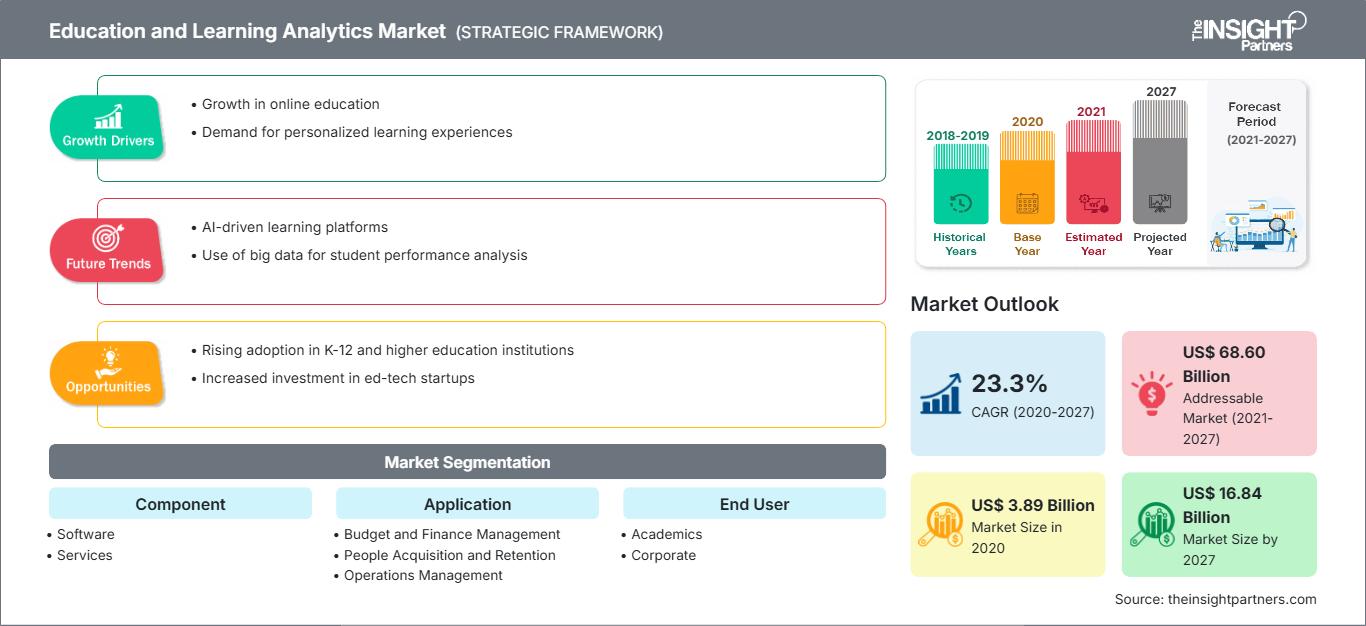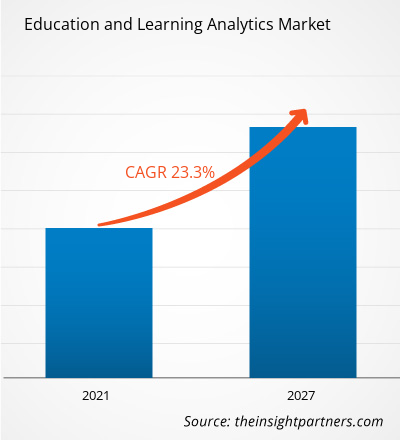[Forschungsbericht]Der Markt für Bildungs- und Lernanalysen wird voraussichtlich von 3.890,3 Millionen US-Dollar im Jahr 2020 auf 16.835,9 Millionen US-Dollar im Jahr 2027 wachsen; die durchschnittliche jährliche Wachstumsrate (CAGR) von 23,3 % wird von 2020 bis 2027 geschätzt.
Die steigende Nachfrage nach Online-Kursen und professionellen Zertifizierungen trägt zum Wachstum des Marktes bei. Die steigende Nachfrage nach Online-Kursen und ein dramatischer Anstieg der Anmeldungen für Online-Programme schaffen enorme Chancen für Anbieter im Markt für Bildungs- und Lernanalysen. Der Markt für Online-Kurse ist aufgrund der großen Anzahl global agierender Akteure stark fragmentiert. Die Anbieter von Lernanalysen müssen sich auf Partnerschaften mit Online-Kursanbietern konzentrieren, um ihre Präsenz weltweit auszubauen.
Online-Lernen wird zu einem wesentlichen Bestandteil der Bildungslandschaft. Die Einschreibungen in Online-Programme werden zunehmend durch die steigende Zahl von Studierenden vorangetrieben, die nach flexiblen Formaten für Zertifikate, Kurse und Studiengänge suchen, um ihre berufliche Karriere zu unterstützen und weiterführende Studien zu absolvieren. Studierende, die in Präsenzprogrammen eingeschrieben sind, legen während ihres Studiums Wert darauf, sich für Hybrid- oder reine Online-Kurse anzumelden. Online-Masterstudiengänge erfreuen sich unter Studierenden großer Beliebtheit, da viele renommierte und große Institutionen aufgrund der hochwertigen technischen Unterstützung im Lernprozess auf verschiedene Online-Studiengänge umsteigen. Darüber hinaus konzentrieren sich auch Unternehmensfachleute auf verschiedene Kurse zur beruflichen Weiterentwicklung. Daher wird erwartet, dass die steigende Nachfrage nach Online-Kursen große Chancen für Anbieter von Bildungs- und Lernanalysen weltweit bietet.
Passen Sie diesen Bericht Ihren Anforderungen an
Sie erhalten kostenlos Anpassungen an jedem Bericht, einschließlich Teilen dieses Berichts oder einer Analyse auf Länderebene, eines Excel-Datenpakets sowie tolle Angebote und Rabatte für Start-ups und Universitäten.
Markt für Bildungs- und Lernanalysen: Strategische Einblicke

- Holen Sie sich die wichtigsten Markttrends aus diesem Bericht.Dieses KOSTENLOSE Beispiel umfasst Datenanalysen, die von Markttrends bis hin zu Schätzungen und Prognosen reichen.
Auswirkungen der COVID-19-Pandemie auf den Markt für Bildungs- und Lernanalysen
Sie erhalten kostenlos Anpassungen an jedem Bericht, einschließlich Teilen dieses Berichts oder einer Analyse auf Länderebene, eines Excel-Datenpakets sowie tolle Angebote und Rabatte für Start-ups und Universitäten.
Markt für Bildungs- und Lernanalysen: Strategische Einblicke

- Holen Sie sich die wichtigsten Markttrends aus diesem Bericht.Dieses KOSTENLOSE Beispiel umfasst Datenanalysen, die von Markttrends bis hin zu Schätzungen und Prognosen reichen.
Zwar gibt es unterschiedliche Ansichten über die Schäden, die COVID-19 verursachen kann, doch Tatsache ist, dass sich COVID-19 weltweit ausbreitet. Die Zahl der Neuinfektionen steigt unter anderem in den USA, Kanada, Europa, Afrika, dem Nahen Osten, Indien, Australien, Südkorea, Indien und Japan. Obwohl die Auswirkungen auf verschiedene Unternehmen bekannt sind, ist der Bildungssektor mit den größten Umbrüchen der jüngeren Geschichte konfrontiert.
Bildungseinrichtungen weltweit reagieren auf Reiseverbote und Quarantänen mit der Umstellung auf Online-Lernen. Der Notfall könnte einen Online-Boom im Bildungsbereich auslösen – oder es kann Länder zumindest besser auf den nächsten Notfall vorbereiten
Markteinblicke – Markt für Bildungs- und Lernanalysen
Zunehmende Nutzung fortschrittlicher Technologien bei Bildungseinrichtungen in Entwicklungsländern
Bildungseinrichtungen investieren massiv in fortschrittliche Technologien, um sich einen Wettbewerbsvorteil zu verschaffen und das bestmögliche Bildungssystem einzuführen. Andererseits sind auch Studenten bereit zu investieren, um die beste Ausbildung zu erhalten. Sowohl Bildungseinrichtungen als auch Studenten haben ein hohes Potenzial, in das technologiegetriebene Bildungssystem zu investieren, was sich stark auf das Marktwachstum auswirkt. Schulen und Universitäten investieren in Technologie, um ihre Bildungsabläufe zu verbessern, beispielsweise in die Finanzplanung, Kursplanung, Studentenbindung und die effektive Bereitstellung von Informationen für Studenten.
Der Bildungssektor hat mit so unterschiedlichen technologischen Fortschritten experimentiert, die von Präsenzprogrammen bis hin zu app-basiertem Lernen reichen. Einige dieser Technologien sind zu einem festen Bestandteil des Hochschulsystems geworden. Die sich rasant entwickelnde Technologie verändert den Bildungssektor.
Fortschrittliche Technologien wie die Big-Data-Analyse bieten Pädagogen beispiellose Möglichkeiten, ihre Schüler auf neue Weise zu erreichen. Sie ermöglichen ein tieferes Verständnis der Lernerfahrungen der Schüler und helfen auch, den Zustand des Bildungssystems zu bewerten. Einige der wichtigsten Bereiche, in denen Big Data im Bildungssektor eine Schlüsselrolle spielt, sind maßgeschneiderte Programme, die Verbesserung der Schülerleistungen, die Reduzierung von Schulabbrüchen und mehr. Ebenso ermöglicht Lernanalysen die Verbesserung des Kursablaufs, des Leistungsmanagements, des Betriebsmanagements, des Finanzmanagements und mehr. All diese mit den Technologien verbundenen Vorteile ermöglichen es Bildungseinrichtungen, intelligente Technologielösungen zu implementieren. Die zunehmende Einführung fortschrittlicher Technologielösungen im Bildungssektor wird voraussichtlich den globalen Markt für Bildungs- und Lernanalysen im Prognosezeitraum ankurbeln.
Komponentenbasierte Erkenntnisse
Basierend auf Komponenten ist der Markt für Bildungs- und Lernanalysen in Software und Dienstleistungen segmentiert. Das Softwaresegment hatte 2019 den größten Marktanteil.
Akteure im Markt für Bildungs- und Lernanalysen konzentrieren sich hauptsächlich auf die Entwicklung fortschrittlicher und effizienter Produkte.
- 2019 investierte das SAS Institute Inc. in die Menschen hinter der Analyse, um die neue Generation für neue Möglichkeiten zu schulen und Arbeitskräfte für eine veränderte Wirtschaft auszubilden. Mehrere neue Programme und Initiativen – alle Teil des umfassenden Engagements von SAS zur Förderung der Analyseausbildung für alle – wurden während des SAS® Global Forum 2019 vorgestellt.
- 2019 erwarb Microsoft DataSense, ein IPaaS-Produkt (Integration Platform as a Service) für Bildungslösungsanbieter und US-Schulbezirke, vom San Franciscoer Unternehmen BrightBytes. Das Entwicklungsteam wird im Rahmen der Transaktion in die globale Bildungsabteilung von Microsoft integriert.
Der Markt für Bildungs- und Lernanalysen ist wie folgt segmentiert: Bildungs- und LernanalysenRegionale Einblicke in den Markt für Bildungs- und Lernanalysen
Die Analysten von The Insight Partners haben die regionalen Trends und Faktoren, die den Markt für Bildungs- und Lernanalysen im Prognosezeitraum beeinflussen, ausführlich erläutert. In diesem Abschnitt werden auch die Marktsegmente und die geografische Lage in Nordamerika, Europa, dem asiatisch-pazifischen Raum, dem Nahen Osten und Afrika sowie Süd- und Mittelamerika erörtert.
Umfang des Marktberichts zu Bildungs- und Lernanalysen
| Berichtsattribut | Einzelheiten |
|---|---|
| Marktgröße in 2020 | US$ 3.89 Billion |
| Marktgröße nach 2027 | US$ 16.84 Billion |
| Globale CAGR (2020 - 2027) | 23.3% |
| Historische Daten | 2018-2019 |
| Prognosezeitraum | 2021-2027 |
| Abgedeckte Segmente |
By Komponente
|
| Abgedeckte Regionen und Länder | Nordamerika
|
| Marktführer und wichtige Unternehmensprofile |
|
Dichte der Marktteilnehmer im Bereich Bildungs- und Lernanalyse: Verständnis ihrer Auswirkungen auf die Geschäftsdynamik
Der Markt für Bildungs- und Lernanalysen wächst rasant. Dies wird durch die steigende Nachfrage der Endnutzer aufgrund veränderter Verbraucherpräferenzen, technologischer Fortschritte und eines stärkeren Bewusstseins für die Produktvorteile vorangetrieben. Mit der steigenden Nachfrage erweitern Unternehmen ihr Angebot, entwickeln Innovationen, um den Bedürfnissen der Verbraucher gerecht zu werden, und nutzen neue Trends, was das Marktwachstum weiter ankurbelt.

- Holen Sie sich die Markt für Bildungs- und Lernanalysen Übersicht der wichtigsten Akteure
- Software
- Dienste
Markt für Bildungs- und Lernanalysen – nach Anwendung
- Leistungsmanagement
- Betriebsmanagement
- Budget- und Finanzmanagement
- Personalgewinnung und -bindung
- Lehrplanentwicklung und Interventionsmanagement
Markt für Bildungs- und Lernanalysen – nach Endbenutzer
- Akademiker
- Unternehmen
Markt für Bildungs- und Lernanalysen – nach Geografie
Nordamerika
- USA Pazifik (APAC)
- Japan
- China
- Australien
- Indien
- Südkorea
- Rest von APAC
Naher Osten und Afrika (MEA)
- Saudi-Arabien
- VAE
- Südafrika
- Rest von MEA
Südamerika (SAM)
- Brasilien
- Argentinien
- Rest von SAM
Markt für Bildungs- und Lernanalysen – Unternehmensprofile
- Watershed Systems, Inc.
- SAS Institute Inc.
- SAP SE
- Microsoft Corporation
- Happiest Minds
- Ellucian Company LP
- Blackboard Inc.
- Alteryx Inc.
- InetSoft Technology Corp.
- Saba Software, Inc.
- Historische Analyse (2 Jahre), Basisjahr, Prognose (7 Jahre) mit CAGR
- PEST- und SWOT-Analyse
- Marktgröße Wert/Volumen – Global, Regional, Land
- Branchen- und Wettbewerbslandschaft
- Excel-Datensatz
Aktuelle Berichte
Erfahrungsberichte
Grund zum Kauf
- Fundierte Entscheidungsfindung
- Marktdynamik verstehen
- Wettbewerbsanalyse
- Kundeneinblicke
- Marktprognosen
- Risikominimierung
- Strategische Planung
- Investitionsbegründung
- Identifizierung neuer Märkte
- Verbesserung von Marketingstrategien
- Steigerung der Betriebseffizienz
- Anpassung an regulatorische Trends




















 Kostenlose Probe anfordern für - Markt für Bildungs- und Lernanalysen
Kostenlose Probe anfordern für - Markt für Bildungs- und Lernanalysen